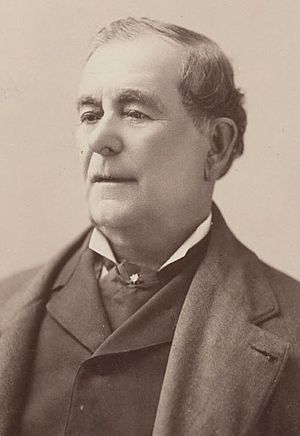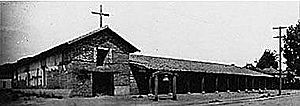Mariano Guadalupe Vallejo facts for kids
Quick facts for kids
Mariano Guadalupe Vallejo
|
|
|---|---|

Mariano Vallejo, c. 1880–1885
|
|
| Born | 4 July 1807 |
| Died | 18 January 1890 (aged 82) Sonoma, California, U.S.
|
| Resting place | Mountain Cemetery, Sonoma, California |
| Occupation | military commander, politician, and rancher |
| Years active | 1808–1890 |
| Spouse(s) | Francisca Benicia Carrillo |
Don Mariano Guadalupe Vallejo (July 4, 1807 – January 18, 1890) was an important leader in California's history. He was a general, a politician, and a rancher.
Vallejo was born when California was part of Spain. He later served as an officer for Mexico when California was a Mexican territory. He played a big role in California becoming a U.S. state. He even served in California's first state government. The city of Vallejo, California is named after him. The nearby city of Benicia is named after his wife, Francisca Benicia Carrillo.
Contents
Early Life and Military Career
Mariano Vallejo was born in Monterey, California. He was one of thirteen children. His father, Ignacio Vicente Ferrer Vallejo, was a respected soldier and later a mayor in San José.
As a teenager, Mariano and his nephew Juan Bautista Alvarado received special lessons from the governor. They learned about government and had access to many books. Vallejo also worked for an English merchant, William Hartnell, who taught him English, French, and Latin.
Vallejo became a personal secretary to the Governor of California. When Mexico became independent from Spain, Vallejo joined the military. He quickly rose through the ranks. In 1829, he led soldiers in a battle against a group of Miwok people.
Rising to Power in California
In 1833, Vallejo became the Commander of the Presidio of San Francisco. He was put in charge of taking over Mission San Francisco Solano from the church. At first, he gave some land to the native workers, as he was told to do. But later, he took all the land and buildings for his own large ranch, Rancho Petaluma Adobe.
Vallejo helped plan the town of Sonoma in 1835. He created a large town square. He even used tiles from the old mission church roof for his own house. Later, the mission church was torn down. In 1840, Vallejo had a new, smaller chapel built for the town.
He also received a large land grant called Rancho Petaluma. In 1835, he became the highest military commander in Northern California. Vallejo started building the Presidio of Sonoma to protect against the Russians who had a settlement at Fort Ross. He moved most of the soldiers from San Francisco to Sonoma. He also built his large two-story home, Casa Grande, in the town square. Vallejo made an agreement with Chief Solano of the Suisunes tribe. This alliance gave Vallejo over a thousand allies in conflicts with other tribes.
In 1836, there was an uprising against the unpopular Mexican governor. Juan Bautista Alvarado led this uprising. Vallejo did not join at first. But after the governor surrendered, Alvarado asked Vallejo to help. Vallejo became a hero and was promoted to colonel. He was named Comandante General of the "Free State of Alta California," and Alvarado became Governor. The Mexican government later approved their new positions.
Challenges and Changes
In 1840, some Americans were causing trouble in California. Vallejo ordered the arrest of about 100 American and English immigrants. Many were deported. Vallejo was pressured by other countries to release the remaining prisoners.
Also in 1841, the Russians at Fort Ross offered to sell their outpost to Vallejo. But the Mexican authorities and Governor Alvarado delayed the sale. Eventually, John Sutter bought the fort instead. This made Vallejo believe that California would be better off if it was no longer ruled by Mexico City. He thought that joining the United States was the best way for California to grow.
Later in 1841, Vallejo met with a group of American immigrants who had entered California without permission. His orders were to send them back to the U.S. However, Vallejo was tired of the Mexican government. He decided to give these immigrants passports instead, especially since they had useful skills.
In 1842, Mexico replaced Vallejo and Alvarado with a new governor, Manuel Micheltorena. This new governor arrived with 300 soldiers who were actually pardoned criminals. These soldiers were not paid, so they started stealing from the people.
The Bear Flag Revolt

On June 14, 1846, a group of Americans, led by William B. Ide, took Mariano Vallejo prisoner. They wanted California to be independent from Mexico. They created a new flag with a grizzly bear on it, which some people thought looked like a pig!
Vallejo actually supported California joining the United States. So, he invited the rebels into his home for a meal. He signed an agreement that said he and his family would not be taken prisoner. However, the rebels outside refused to agree. They insisted that Vallejo and other Mexican officers be held as hostages.
Vallejo felt that these rebels were just a "rabble." He wrote that if they had used the American flag, there would have been no conflict. But because they used a bear flag, which he saw as a symbol of "robbery and force," Californians thought they were dealing with criminals.
Vallejo, his secretary, his brother Salvador Vallejo, and his brother-in-law Jacob P. Leese were taken to John C. Frémont's camp. Vallejo thought Frémont, whom he considered a friend, would release them. But Frémont ordered them to be held at Sutter's Fort.
Conditions at the fort were tough. Mariano became sick with malaria. He was released on August 2, 1846, after agreeing to stay neutral in the war with Mexico. He weighed only 96 pounds. After his release, Vallejo decided to support the Americans. He showed his loyalty by burning his Mexican military uniform.
California State Politics
After the United States won the war against Mexico, Vallejo helped convince wealthy Californians to accept American rule. He was an important member of the group that wrote California's first Constitution. In 1850, he was elected to the first State Senate.
In 1850, Vallejo offered to give 156 acres (0.63 km²) of his land to the new state government. He wanted them to build a new state capital there. He also offered to pay for much of the construction. The state accepted his offer, and the new city was named Vallejo. The state legislature met there for the first time in 1851. However, construction was slow, and the buildings were not good. Within three years, the capital was moved to Sacramento.
Land and Family Life
Even though a treaty was supposed to protect the land rights of Mexicans in the U.S., Vallejo faced long legal battles. These battles cost him a lot of money and he lost almost all of his land and animals. Many other Californians also lost their lands because they could not afford the legal fees.
Mariano Vallejo married Francisca Benicia Carrillo in 1832. Francisca was from a leading family in San Diego. They had many children together.
Mariano's younger brother, Salvador Vallejo, was also a military officer and rancher. He served in the Union Army during the Civil War, but did not fight in battles. Mariano's sisters also married important figures in California.
By the time he died on January 18, 1890, Vallejo lived a simple life on a small part of his former lands at his Lachryma Montis home in Sonoma, California. His wife, Francisca, died a year later. They are both buried in Mountain Cemetery in Sonoma.
Legacy
The city of Vallejo, California and a U.S. Navy submarine, the USS Mariano G. Vallejo (SSBN-658), were named in his honor.
Vallejo's Rancho Petaluma Adobe is now a protected historic park. His home in Sonoma, California, where he lived for over 35 years, is now a museum and cultural center.
In 2017, a bronze statue of General Vallejo was placed in Sonoma Plaza. It has a plaque that describes his many roles as a Spanish, Mexican, and American leader.
Children
| The children of Mariano G. Vallejo and Francisca B. Vallejo (1815–1891) | |||
|---|---|---|---|
| Name | Birth/Death | Married | Notes |
| Andronico Antonio Vallejo | 1833–1834 | ||
| Andronico Antonio Vallejo | 1834–1897 | Never married | |
| Epifania de Guadalupe Vallejo | 1835–1905 | April 3, 1851 John B. Frisbie (1823–1909) |
|
| Adelayda Vallejo | 1837–1895 | July 26, 1858 Levi Cornell Frisbie (1821–1892) |
|
| Natalia Veneranda Vallejo | 1838–1913 | June 1, 1863 Attila Haraszthy (1834–1886) |
|
| Plutarco Vallejo | Died: Age two | ||
| Platon Mariano Guadalupe Vallejo | 1841–1925 | June 5, 1885 Lily Wiley (1849–1867) |
|
| Guadalupe Vallejo | Died: Age four | ||
| Jovita Francisca Vallejo | 1844–1878 | June 1, 1863 Arpad Haraszthy (1840–1900) |
|
| Uladislao Vallejo | 1845 – Unknown | c. 1890 Maria ? |
|
| Plutarco Vallejo | Died: three months | ||
| Benicia Vallejo | 1849–1853 | ||
| Napoleon Primo Vallejo | 1850–1923 | Married: 1875 Divorced: 1890 Remarried: 1911 Martha Brown (1854–1917) |
|
| Benicia Vallejo | 1854–1861 | ||
| Luisa Eugenia Vallejo | 1856–1943 | August 23, 1882 Ricardo de Emparan (1852–1902) |
|
| María Ignacia Vallejo | 1857–1932 | May 12, 1878 James Harry Cutter (?–1925) |
|
See also
 In Spanish: Mariano Guadalupe Vallejo para niños
In Spanish: Mariano Guadalupe Vallejo para niños




